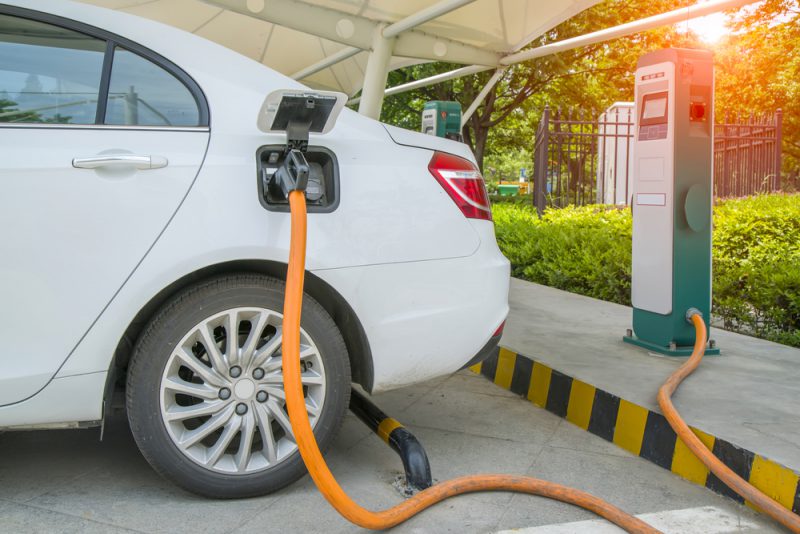Southern California Edison pushes for major expansion of EV charging station infrastructure

Southern California Edison (SCE) is adding thousands of additional charging stations to their Charge Ready program, a pilot program to increase availaility of charging ports for passenger electric vehicles (EV). Since 2016, SCE has installed 1,000 charging stations throughout their service area of Southern and Central California.
The program is meant to clean up California in a variety of ways. From reducing emissions to helping lower-income areas consider EVs for the first time, the goal of the new program is to help 80 percent of the state’s grid become carbon-free by 2030.
To do this, the utility’s near-term goals are the acceleration of transportation electrification, including 7 million EVs on the road by 2030, and electrifying one-third of space and water heaters in their territory.
“We really do see transportation and the electrification of the transportation sector as a cornerstone of moving forward the clean energy economy,” said Katie Sloan, principal manager of Innovation, Development and Controls with SCE. “So we really want to be part of that future and help to lead the state’s ambitious goals, and we won’t be able to do that unless we clean the transportation sector, which is responsible for over 40 percent of greenhouse gas production.”
The utility has filed plans with the California Public Utilities Commission (PUC) for an additional 48,000 charging ports in a $760 million program. It expects to have 1,250 new charging stations at 60 locations installed by the end of 2018.
The new installations will be focused on apartment complexes, condo buildings, workplaces, schools, hospitals, and low-income neighborhoods or those affected by pollution.
In the report filed with the PUC, the utility explained: “In California, transportation electrification represents the largest near-term opportunity to reduce GHG emissions and air pollution.”
The utility is focusing on a few angles to increase the use of EVs in their service area, including range anxiety. While range anxiety is still an issue utilities are dealing with, Sloan said they have seen those fears subsiding.
“We are seeing that as the battery range is larger and larger, that there is some lessening of range anxiety,” she explained. “That said, range anxiety and lack of charging availability seem to be a very large barrier to adoption of electric vehicles, and that’s why we’re focused on providing a third of the need of charging stations that we see in our area to help eliminate some of those areas.”
But despite SCE’s efforts to increase charging stations and decrease range anxiety within its service area, the utility is not working with partners to extend those electric highways.
“We’re focused on the infrastructure in our service area, which is largely southern California and part of the middle of the state,” Sloan explained. “However, it makes sense that other areas are providing electric vehicle charging infrastructure that will only help to sway some of the range anxiety and lack of availability concerns that there are.”
There are programs such as the West Coast Electric Highway, which extends from Southern California to Vancouver, British Columbia, but SCE is not involved in the project.
Another focus of the utility’s request is to install one-third of its new stations in “communities that are disproportionately affected by pollution and economic hardship.”
According to SCE, more than half of the charging stations it added during the pilot phase of the program were in similar communities, and the utility plans to increase word-of-mouth campaigns and community outreach.
It outlined a process for this outreach, including communicating with community- and faith-based organizations.
“These organizations can help communicate through their established relationships with customers in disadvantaged and low- or moderate-income communities,” the report explained. “By working with these organizations, SCE will connect with hard-to-reach audiences, using trusted community resources.”
The plan also includes increasing utility presence at industry and automotive events.
While the new program is not expected to bring charging stations to private homes, SCE is working on a separate pilot program focused on providing a rebate on charging infrastructure in the home. The utility is also planning to launch more Charge Ready pilots, including supporting medium- and heavy-duty trucks, transit buses, port equipment, and other industrial vehicles.
If approved, the new phase for the Charge Ready program will move the utility past their pilot program and onto a full-scale launch.
“What we’re really seeing today is a shift from pilots, which we’ve done quite a few of across the state in the past,” Sloan said. “But we’re seeing policy, customer demand, environmental and community needs, and technology trends really coming together so that we can take what we’ve done in the pilot and move more into scale. And so we’re really pushing forward the state for swift and bold action so that we can get where we’re going.”
